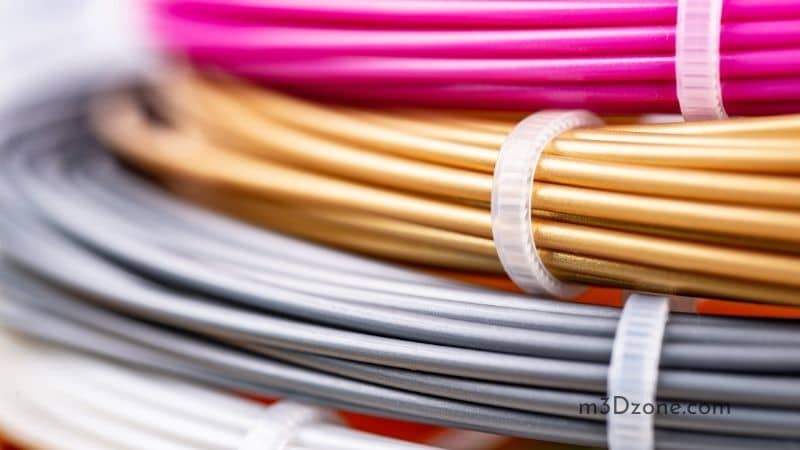With the constant technology inventions, more materials are used for 3D printing. No longer is the 3D printing market limited to polymers as there are various materials to tap into.

As an Amazon Associate, I earn from qualifying purchases. If you make a purchase after clicking on a link I may earn a small commission at no extra cost to you.
Plastics, metals, and ceramics can produce a diverse range of products to suit different applications. Did you know even soybean oil, chocolate, and wet paper can also make 3D prints? Read on to discover how to choose these materials and which ones you can’t use.
Quick Navigation
What Materials Are Used in 3D Printing?
Let’s see the crucial characteristics and downsides of the different materials used in 3D printing.
Nylon
Nylon is a synthetic thermoplastic polyamide and is the most popular plastic substance used for 3D printing. What makes it an ideal choice for 3D prints is its flexibility, low friction, and durability. This material is also a common choice for textiles and making accessories.
Nylon filament (see on Amazon) is an ideal option for complicated or delicate geometries. It’s majorly used as a filament material in Fused Filament Fabrication or Fused Deposition Modeling 3D printers. It’s inexpensive and one of the sturdiest plastic materials.
Pros
- It’s a durable material.
- It has a good strength-to-flexibility ratio.
- It has minimal warping.
- It’s easy to dye or color.
Cons
- It’s hygroscopic hence needs to be kept dry.
- It has a one-year shelf life.
- It may shrink during cooling, making prints less precise.
- It’s not compatible with all printers.
ABS Plastic
This thermoplastic filament material is a top choice for use as a 3D printer filament. ABS is also one of the most commonly used materials for household and personal 3D printing.

ABS is a good option for engineers and manufacturers who need high-quality prototype products.
Pros
- ABS is easy to access.
- It has a budget-friendly price (see on Amazon).
- It comes in numerous colors.
- It’s more durable than nylon.
Cons
- It needs a heated bed while printing.
- It’s likely to warp if cooled while printing due to its high melting point.
- It’s non-biodegradable.
- It emits toxic, foul-smelling fumes at high temperatures.
High Impact Polystyrene (HIPS)
This material is used in FDM printers as a support structure. Its ease of use can be likened to ABS. However, the two differ in their capacity to dissolve. For instance, HIPS is completely soluble in limonene.
Pros
- It’s easy to cut.
- It can make complicated models and as support material.
- It’s lightweight and smooth.
- It’s impact-resistant and water-resistant.
- It’s affordable (see price on Amazon).
Cons
- It may clog up your printer’s delivery tube and nozzles without proper heat flow.
- It produces unpleasant-smelling fumes.
Resin
Here is another common choice for 3D printing. Resin materials are typically used in DLP, SLA, CLIP, and Multijet technologies. Several kinds are compatible with 3D printing, including tough resin, castable resin, flexible resin, and more.
Pros
- Resin is usable in numerous applications.
- Resin has low shrinkage.
- It’s highly chemical resistant.
Cons
- Resin is quite expensive (see price on Amazon).
- Resin expires.
- High photo-reactivity, hence need proper storage.
- May prematurely polymerize if exposed to heat.
Polylactic Acid (PLA)
PLA comes from renewable resources like cornstarch and sugarcane. It’s a typical choice in learning institutions due to its ease of printing and safety. Moreover, PLA is applicable in FDM desktop printing.
Pros
- Low warping, hence effortless to print with.
- PLA is printable on a cold surface.
- PLA is suitable for printing sharper features and corners than ABS.
- PLA is available in multiple colors (see on Amazon).
Cons
- PLA isn’t very sturdy.
- Can deform with extreme heat exposure.
Gold and Silver
These metal filaments get processed in powder form and are some of the sturdiest for use in 3D printing. They are mostly used to make jewelry. Printing processes used with these metal filaments include Direct Metal Laser Sintering and Selective Laser Melting.
Pros
- High electrical conductivity.
- Heat-proof and durable.
Cons
- Very expensive.
- Time-consuming and tedious to perfect.
- High reflectivity and thermal conductivity, making them difficult to work with.
- Require extremely high temperature hence not suitable for printing in typical FDM 3D printers.
Stainless Steel
Fusion and laser sintering (see 3D printer) are the methods used when printing with stainless steel. This material works with two types of technologies: DMLS and SLM. Given stainless steel is good for constructing sturdy materials and detailed work, it’s ideal for things like key chains, bolts, and miniatures, among others.
Pros
- It’s heat-treatable to enhance hardness and strength.
- It’s ideal for high-strength applications.
- It’s highly corrosion-resistant.
- It has high ductility.
Cons
- It’s time-consuming to print.
- It’s not budget-friendly.
- Limited printing size.
Titanium
This is the lightest and strongest 3D printing material and has a moderate surface roughness. Titanium gets printed via Direct Metal Laser Sintering. The main application of titanium filaments is in high-tech fields like medicine, space exploration, and the aerospace industry.
Pros
- It offers more resolution and complexity in design.
- It’s suitable for high-precision applications.
- It’s corrosion-resistant and biocompatible.
Con
- It’s quite expensive.
Ceramics
Ceramics can withstand extreme pressure and temperature without warping or breaking. It’s less likely to get corroded and doesn’t easily wear away. Therefore, it’s more long-lasting than metals and plastics.
Ceramics are typically used with Binder Jetting technology, Stereolithography, and DLP (Digital Light Processing).
Pros
- They’re suitable for high-precision works.
- They provide smooth, glossy finishes.
- They’re highly resistant to heat, acid, and lye.
- They come in many colors.
Cons
- Ceramics require very high temperatures to melt.
- They’re not ideal for glazing and kilning processes.
- They’re fragile, hence not suitable for interlocking and enclosed components.
- Not excellent for piece assembly procedures.
Polyethylene terephthalate (PET/PETG)
PET is another frequently used plastic material for 3D prints employed in thermoforming processes. It can also create engineering resins when combined with other substances like glass fiber.

In 3D printing, PETG is more common than PET as the former contains modified glycol. As a result, it’s clearer, less brittle, and less strenuous to use than PET. The filament (see on Amazon) works with FFF and FDM technologies.
Pros
- The material is durable.
- It’s recyclable and impact-resistant.
- It’s sterilizable.
- It has excellent adhesion properties.
- Highly temperature-resistant and sturdy.
- It’s easy to print.
Cons
- Degrades under UV light.
- The surface tends to scratch.
- It requires additional testing with 3D printing parameters.
What Is the Most Common 3D Printing Material?
From all the 3D printing materials in use, plastic is the most popular. It’s loved for many different applications, including the making of household fixtures, 3D-printed toys, desk utensils, action figures, and vases.
Plastic is available in transparent and vibrant hues, with lime green and red being the most common. These filaments are packaged in spools and may come in matte or shiny finishes.
Given its firmness, smoothness, flexibility, and brilliant colors, its popularity is easy to comprehend. Not to mention, it’s a relatively affordable option compared to other 3D printing materials.
Plastic consumer products typically use FDM printers. The process involves the melting and molding of thermoplastic filaments into different shapes sequentially. The most common types of plastics for 3D printing include:
- PLA, which is one of the most environmentally-friendly materials used in 3D printers. It’s available in hard and soft forms. Plastics crafting from polylactic acid are likely to be the most preferred in 3D printing in the coming years.
- ABS filament is available in various colors and is popular in stickers and toy making. It’s also used for vases and jewelry.
- Polyvinyl Alcohol Plastic: it’s a typical choice for affordable home printers. Though not ideal for products that require high strength, it’s a good choice for temporary-use products.
- Polycarbonate: it is the least used plastic in 3D printing. It only works in 3D printers operating at high temperatures and with nozzles. It’s used in making molding trays and affordable plastic fasteners, among others.
Plastic items made in 3D printers come in various shapes and consistencies, from flat and round to grooved and meshed.
What Materials Cannot Be 3D-printed?
You cannot print materials unable to melt into a semi-liquid state able to get extruded. Take the operation of FDM 3D printers, for instance. These printers melt thermoplastic substances from a spool, having a tight tolerance of ± 0.05 or lower.
Materials which burn at high temperatures instead of melting are difficult to extrude through the nozzle.
We can use Selective Laser Sintering to bind powdered metals into solid models.
Provided you can meet the tolerances and semi-liquid state, it should be possible to print that substance. Here are some materials you cannot use for 3D printing:
- Plain wood or wood products (However, you can combine wood grains with PLA and use them for 3D printing).
- Fabrics/ Clothes.
- Dry paper.
- Rocks and soil- although you can melt volcanic rocks into a molten state.
- Leather and animal products.
Choosing the Right 3D Printing Material
When printing 3D models, you have first to consider your type of material. We’ve already seen the advantages, demerits, and applications of different 3D printing materials above.
Let’s take a keener examination to see what to look for in them.
-
Tensile Strength
This refers to your material’s resistance to snapping under tension. It not only indicates a material’s ductility but can also denote its strength. Some substances break sharply while the more ductile, like metal and plastic, experience deformation before snapping.
Mechanical, structural, and static components need high tensile materials as breakages are unacceptable. Examples of sectors that require high tensile materials are construction, aviation, and automotive. Nowadays, 3D printing delivers similar or even higher tensile models than previous injection-molded plastics like ABS and polypropylene.
-
Young’s Modulus
This denotes a material’s resistance to length changes under tensile stress. Stiff materials have a high Young’s modulus and are more resistant to change. When selecting materials for structural and mechanical components, a high Young modulus is crucial.
-
Elongation
Elongation is the extent of a material’s stretching exactly at the breaking point. Stiff materials, like brittle-hard plastics, usually have a low elongation, while soft, elastic materials stretch multiple times before breaking.
Elongation is necessary for architecture and construction, where structures need to deform noticeably rather than suddenly snap.
-
Flexural Strength
Flexural strength is also a material’s breakage resistance under load, like tensile strength. However, the loads differ with flexural strength encompassing the bending. Therefore, it reflects on a material’s tensile strength and compression.
Most plastics have closely aligning tensile and flexural strengths. Some materials with a homogeneous structure have the same tensile and flexural strengths. SLA is homogenous, which is an advantage over other 3D printing technologies. This is because components have analogous strength irrespective of the orientation.
-
Flexural Modulus
This refers to a material’s resistance to bending. Stiff materials have a high modulus, while elastic ones have a low modulus. Flexural and Young’s modulus also have a close relation.
Flexural modulus is vital when constructing steel springs, especially leaf springs, and in structural parts or support beams.
-
Impact Strength
Materials have different responses to static load and sudden impact. Impact strength greatly influences a material’s toughness. Brittle materials have minimal toughness due to the limited deformation they can endure. Temperature also impacts the toughness, with low heat levels reducing a material’s toughness.
This factor is crucial in various applications, like making safety goggles and shields.
-
Water Absorption
Plastic materials absorb some water in humid conditions or if submerged. Despite some plastics having a higher hygroscopy than others, the minimal difference may be irrelevant in finished plastic products. However, it’s a crucial consideration for heat resistance in plastic parts and raw material processing.
When plastic materials get heated above approximately 150°C, the presence of moisture results in hydrolysis. This then causes the cracking of long-chain to short-chain molecules, thereby weakening the material. If this occurs before 3D printing, it weakens the material, resulting in poor-quality products. Therefore, you should store raw materials having a high water absorption capacity in dry conditions.
New Innovative 3D Printing Materials
3D printers are no longer majoring in plastics. Some of the latest 3D printers are compatible with recycled materials.
For instance, one designer developed a 3D printer able to use wet paper fibers. It’s sturdy, long-lasting, and offers a good solution to plastic materials. Moreover, it provides an efficient cyclic system as it can recycle finished products once they are old.
The food industry has some of the latest innovations in 3D printing. Company Universal Favourite developed a 3D-printed mold for the creation of a unique chocolate line.
New polymers for 3D printing of medical implants are on the rise. For instance, Evonik, a specialty chemical brand, launched an implant-grade PEEK filament. According to them, this new material is the pioneer PEEK-based filament usable in maxillofacial surgery and orthopedics.
Conclusion
The above 3D printing materials guide will make it easy for you to choose the right material for your task. With the diversification of the 3D printing industry and the world, additional filaments will be available for use.
Picking the right materials is imperative for efficient 3D printing. With a good understanding of the different materials available for 3D printing, operations can become swift and produce high-quality products.
Recommended Reading
Is UV Resin Toxic? Things You Need to Know!
Is UV Resin Toxic? Definitely yes! You need to understand some important facts before using UV resin. Use UV resin with protective gear. Find out more!
Why Is It Important to Have a Filament Runout Sensor?
The problem is a lot of printers do not recognize when filament runs out. This is where the filament runout sensor comes into play. Let's find out more!
Can You 3D Print Carbon Fiber?
Can You 3D Print Carbon Fiber? Yes, You can 3D print using carbon fiber. Carbon fiber enjoys a high strength to weight ratio...
